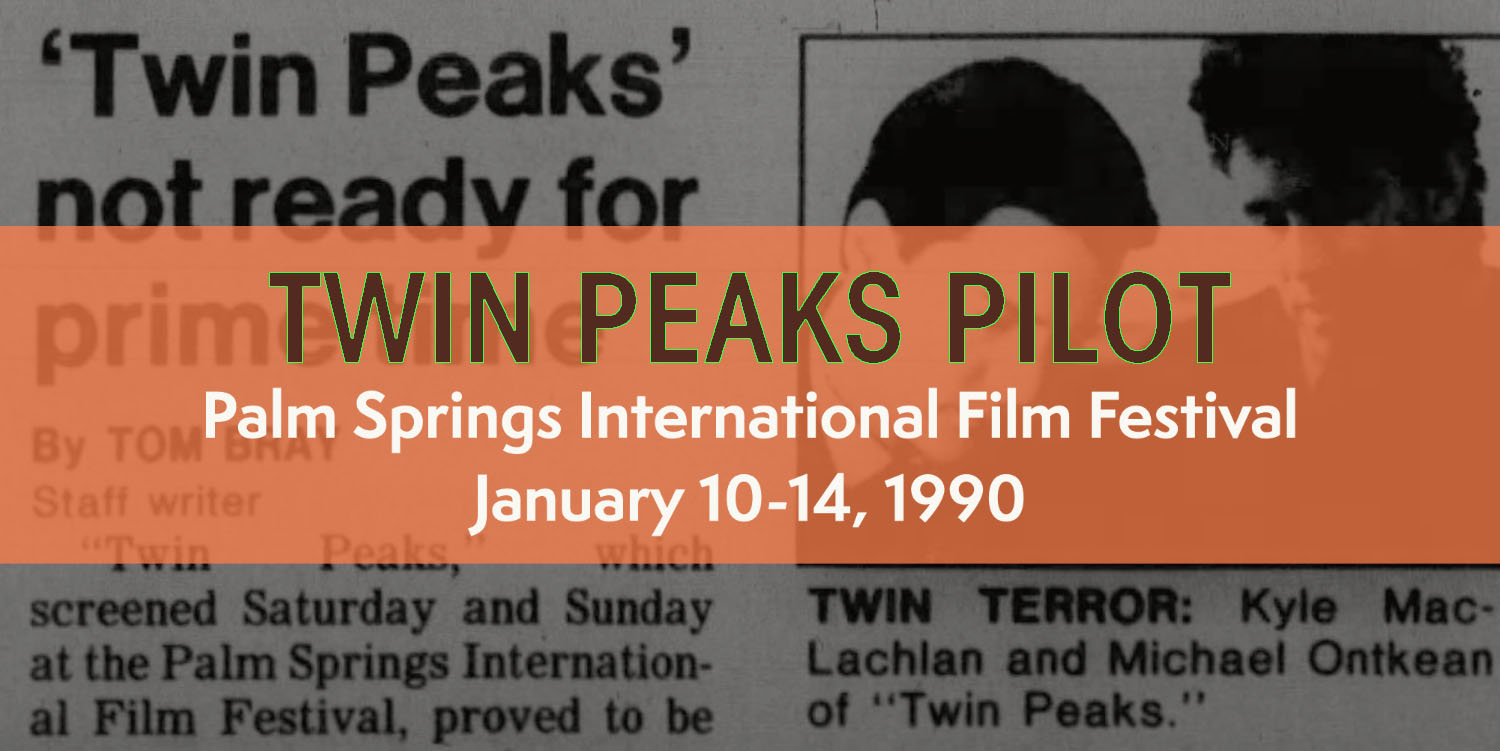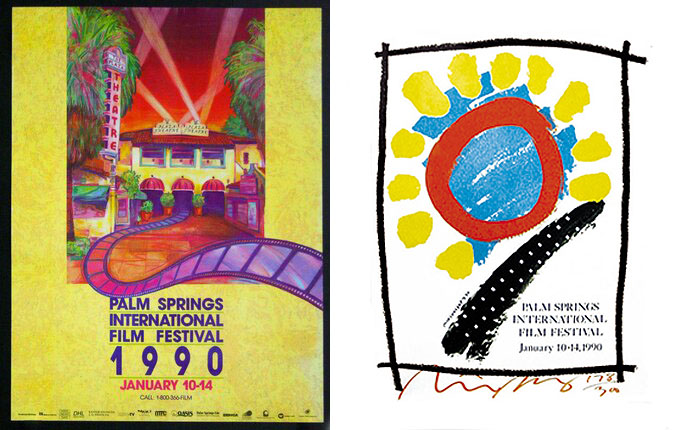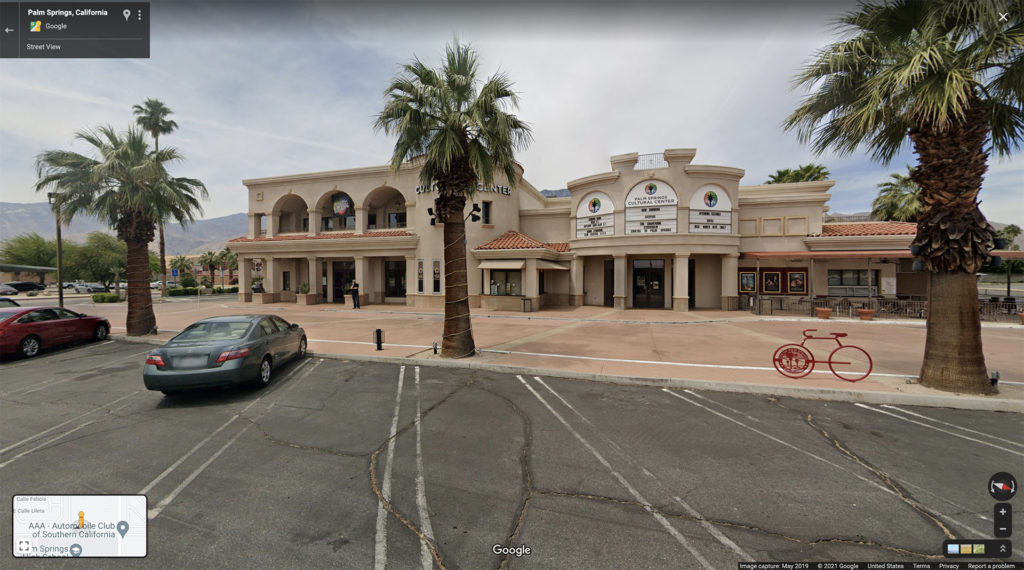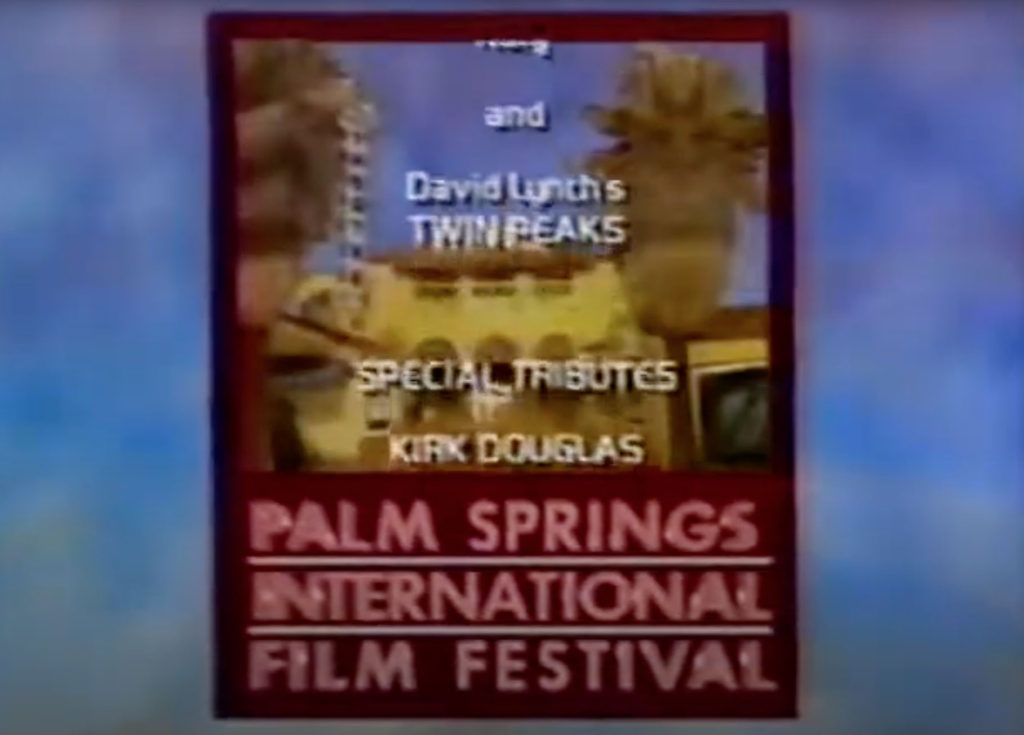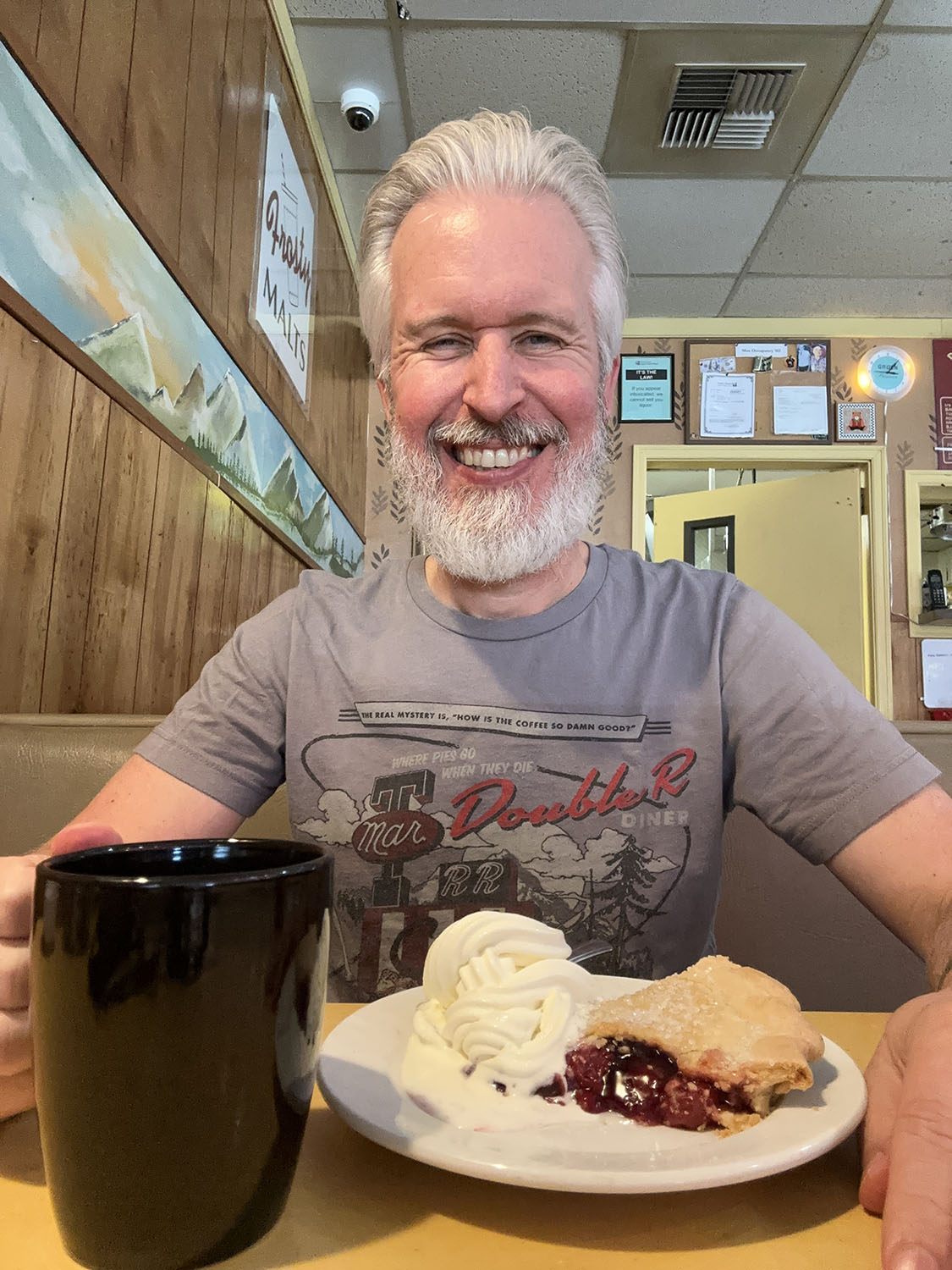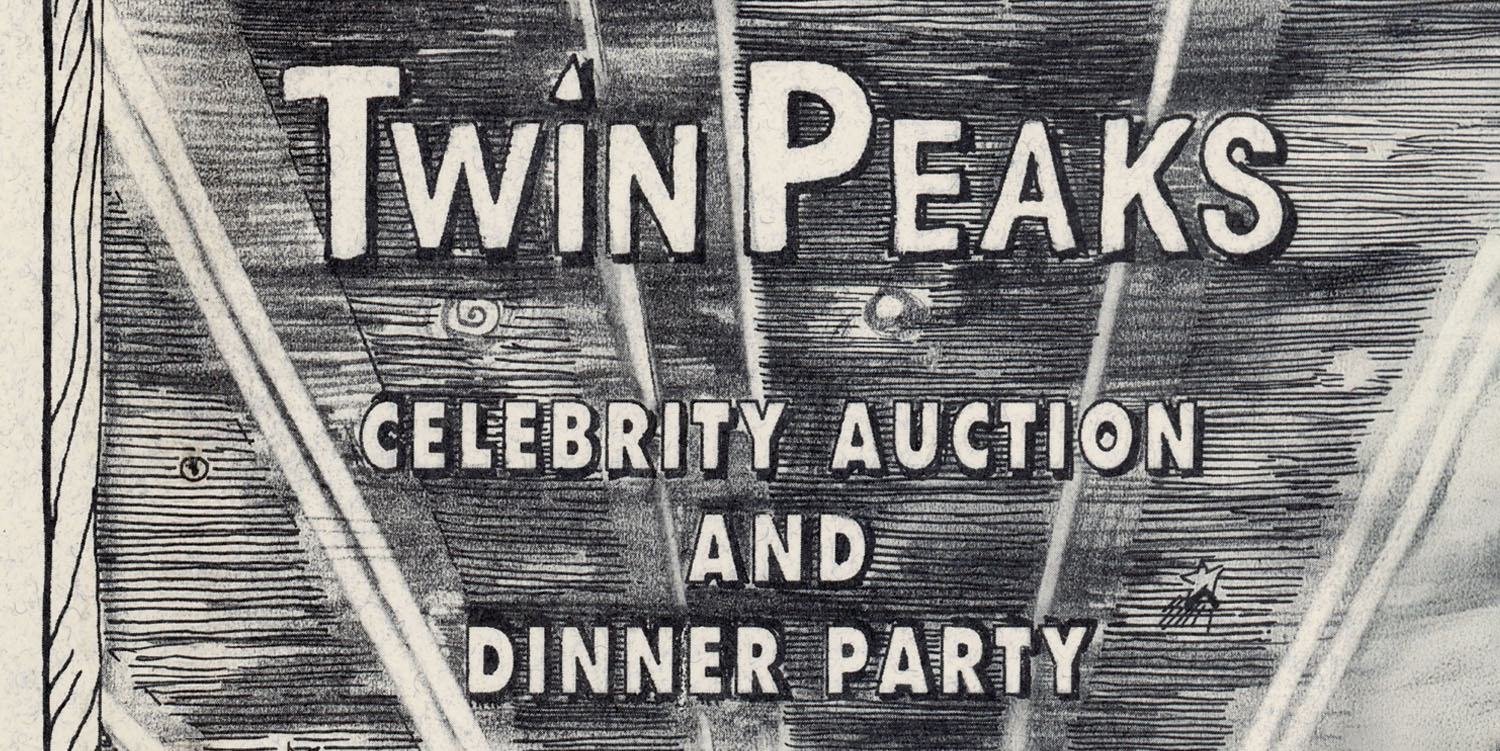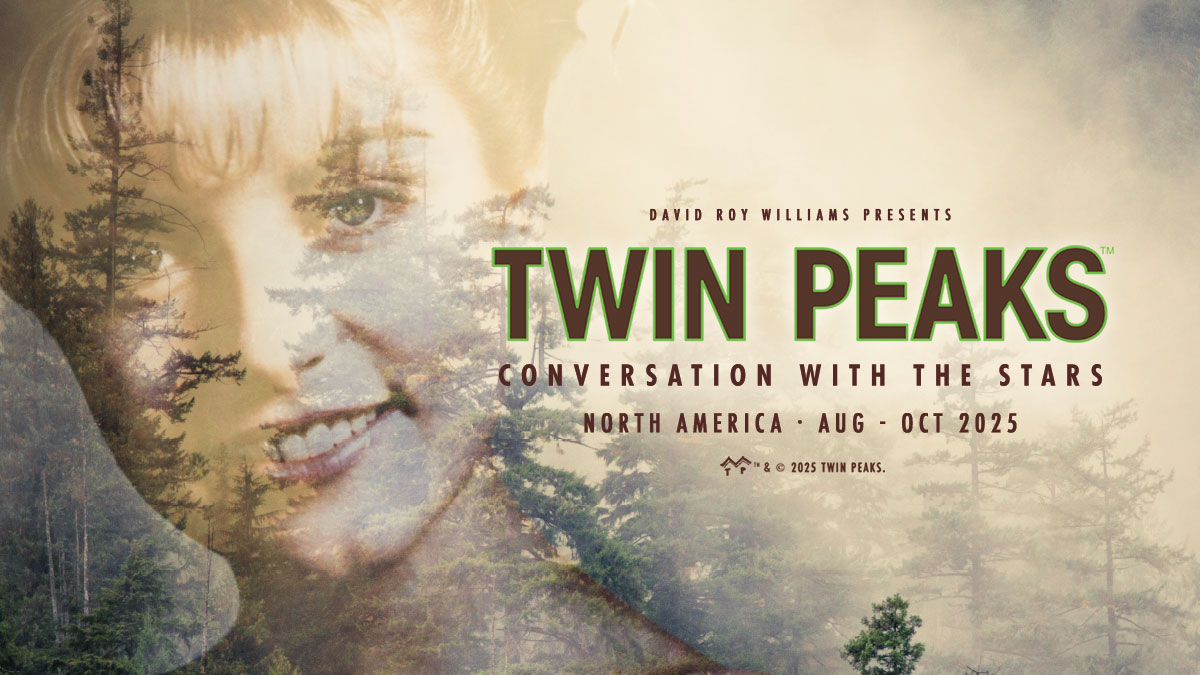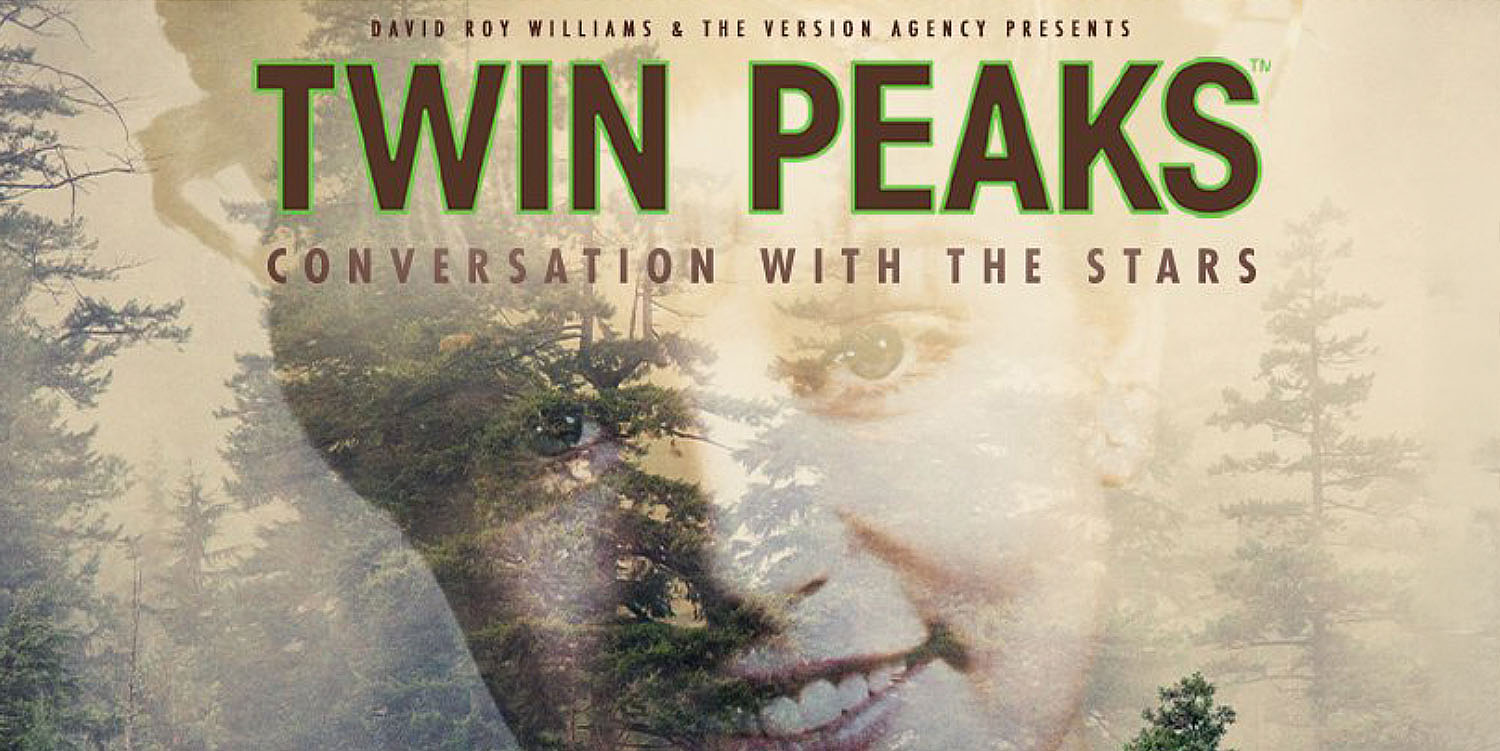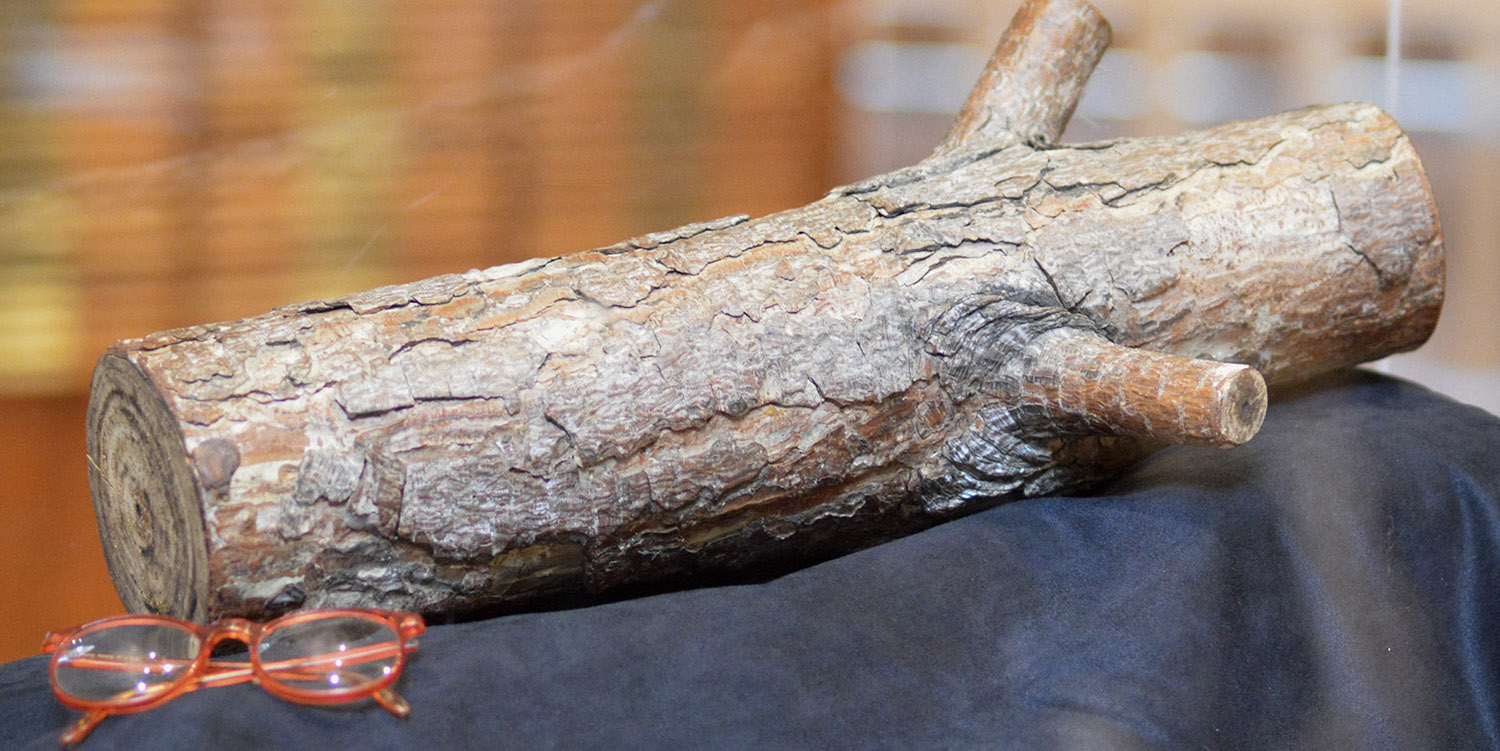To kick off the 1990s, the Twin Peaks pilot continued the festival circuit with a West Coast premiere at the Palm Springs International Film Festival. This inaugural event was held from January 10-14 that year. The episode was screened twice, including a primetime screening in a historic downtown theater.
INAUGURAL YEAR OF PALM SPRINGS INTERNATIONAL FILM FESTIVAL
The Palm Springs International Film Festival was the dream of then mayor Sonny Bono who was elected to office in 1988. Six months into his term, he was already seeking ways to “put more sizzle into Palm Springs life.” On January 8, 1989, he told Jay Clarke from the Chicago Tribune that a producer, staff and sponsors were already in place for the festival event planned for January 1990.
“There are a lot of film festivals around. But it’s not the event, it’s how you produce it,” explained Bono. “I see this more like a European event, like Cannes or Deauville. Palm Springs reeks with glamour and it’s unique in its physical set-up. We can match that.”
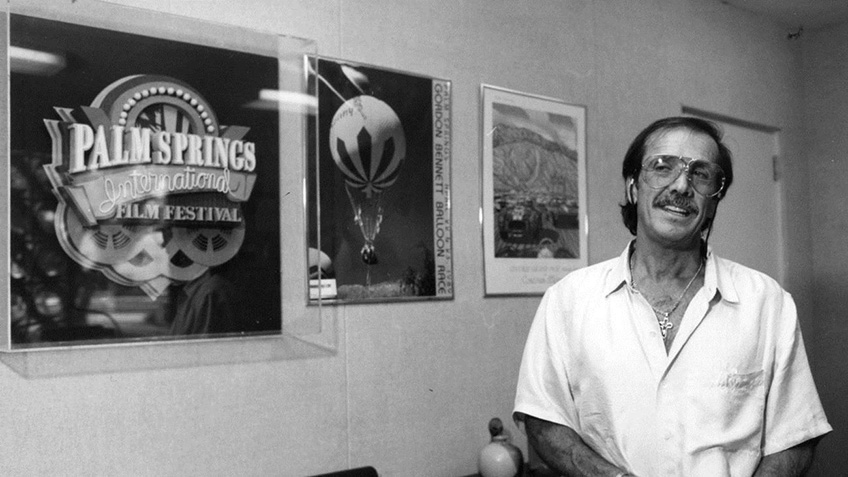
According to the Palm Springs International Film Society, Mayor Bono spent most of 1989 leading the charge to bring major sponsors on board, including American Airlines, Metropolitan Theatres, and Wells Fargo Bank. He also brought a number of key members of the local community onto the Board in those early years for funding support and to help with the overall task.
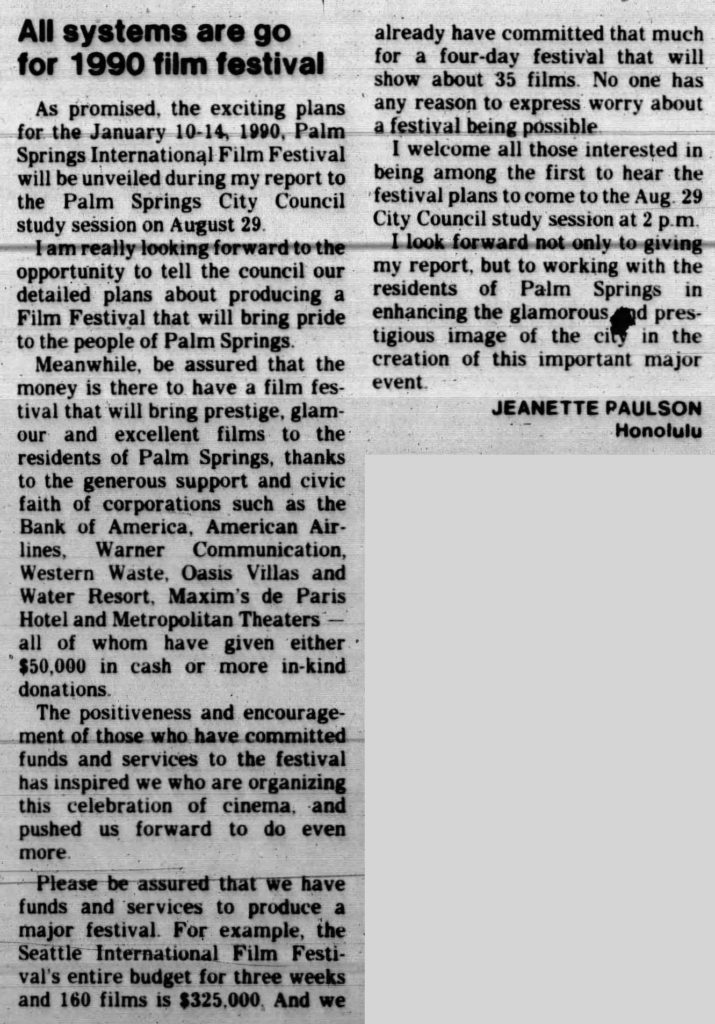
In February, Sonny hired Jeanette Paulson to serve as Festival Director. She had launched the successful Hawaii International Film Festival in 1981. As early as February 1989 (the same time production on the Twin Peaks pilot was beginning), the festival was to have a comedy theme, complete with a tribute to Lucille Ball. They also set a fundraising goal of $1 million. The theme evolved in the ensuing months, and plans were presented to the public during a Palm Springs City Council meeting on August 29.
THE LINE UP AT 1990 PALM SPRINGS INTERNATIONAL FILM FESTIVAL
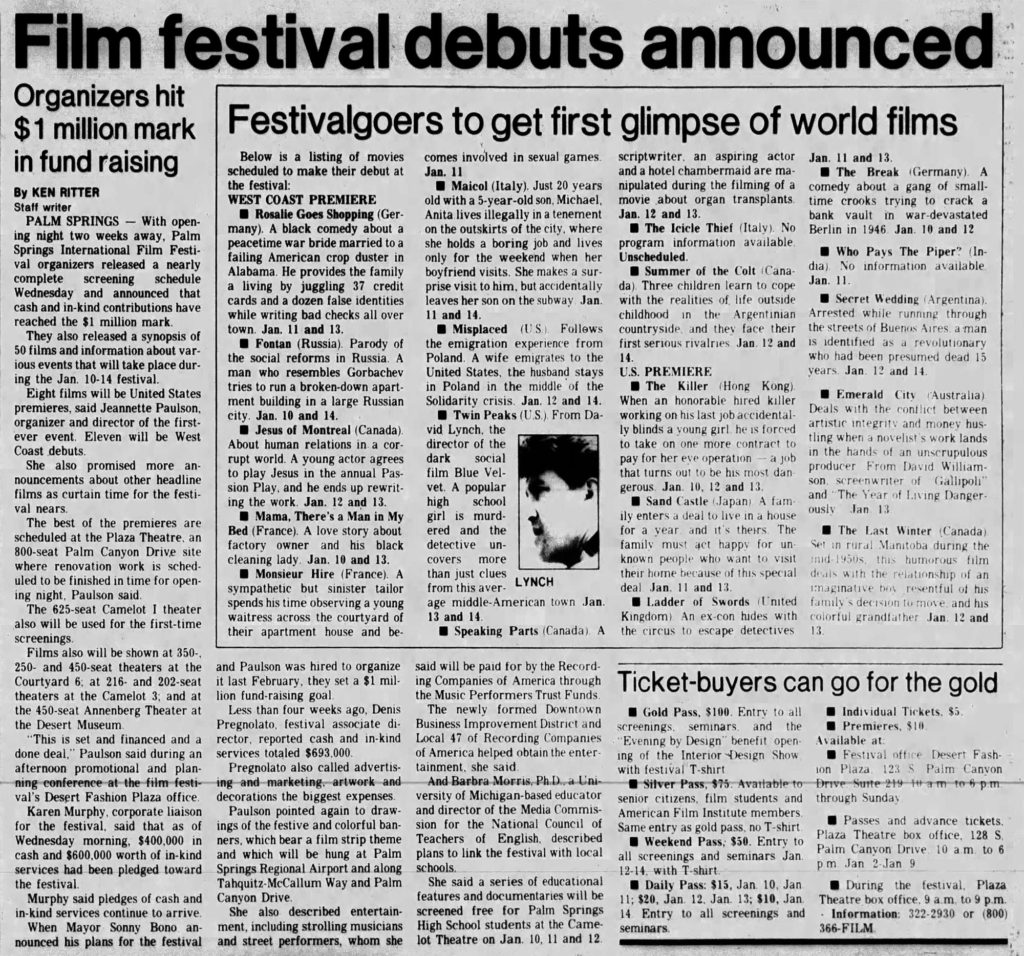
With about two weeks until the start of the festival, organizers revealed that 50 films would be shown during the course of the four-day event. Films would be shown at multiple theaters throughout the Palm Springs area. They also reported they reached their $1 million fundraising goal with cash and in-kind contributions.
At the festival, eight films would be United States premieres and eleven film would receive West Coast debuts. The latter included David Lynch and Mark Frost’s Twin Peaks. A December 28 issue of the Desert Sun ran this description along with a photograph of David Lynch:
Twin Peaks (U.S.) From David Lynch, the director of the dark social film Blue Velvet. A popular high school girl is murdered and the detective uncovers more than just clues from this average middle-American town.
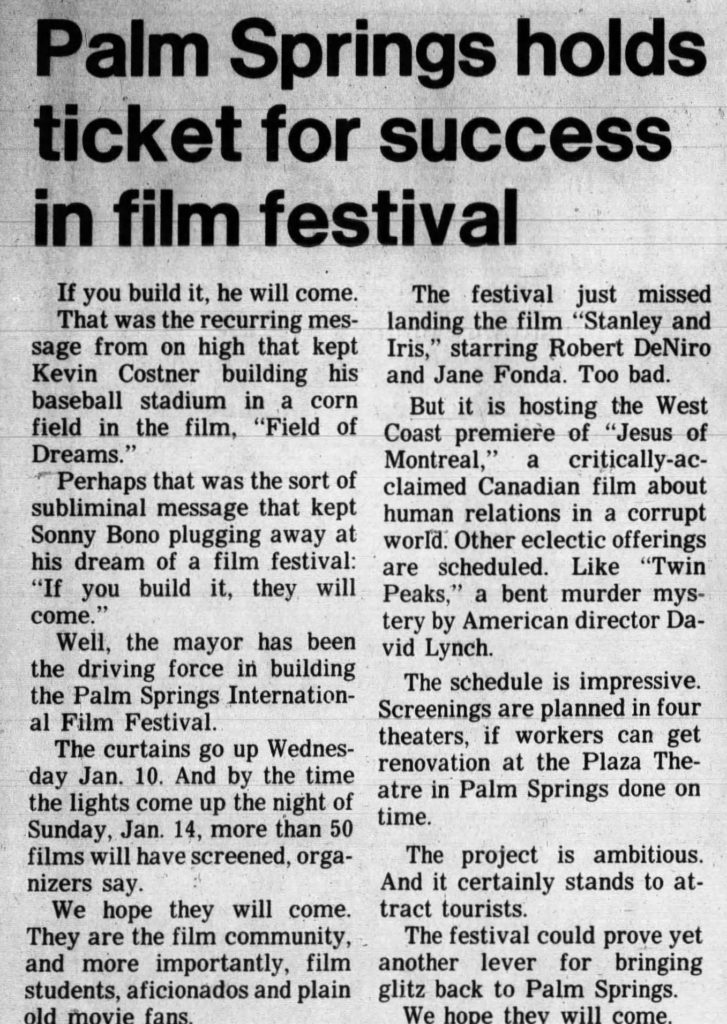
A few days later on January 2, 1990, The Desert Sun ran an editorial piece which included a nod to Twin Peaks: “Other eclectic offerings are scheduled. Like ‘Twin Peaks,’ a bent murder mystery by American director David Lynch.”

A longer synopsis of the pilot appeared in The Desert Sun five days before the start of the festival. I need to write an article about how Twin Peaks was described to people before it debuted. A common description echoed in this synopsis is “Blue Velvet meets Peyton Place“:
This wonderfully subversive new feature from writer-director David Lynch (ERASERHEAD, THE ELEPHANT MAN, BLUE VELVET) comes self-described as “BLUE VELVET meets PEYTON PLACE” and, indeed, all the best elements of these two American classics are abundantly evident in TWIN PEAKS. The setting is a fictional northwestern logging town, but its real location is within the American collective unconscious. As with BLUE VELVET, Lynch deftly peels away the veneer of apparent normalcy of life in Middle America, revealing the corruption that may reside in even the most seemingly wholesome of hearts. Laura Palmer, the most popular girl in town–the high-school Homecoming Queen, no less–has been brutally murdered. F.B.I. Special Agent Dale Cooper (Lynch’s perennial alter-ego Kyle MacLachlan) arrives in town to investigate the murder. In the course of his inquiry, he unearths much about the town and its denizens that perhaps had been better left buried. Lynch and his co-writer Mark Frost have woven a labyrinthine web that would do any self-respecting black widow proud.
JANUARY 10, 1990
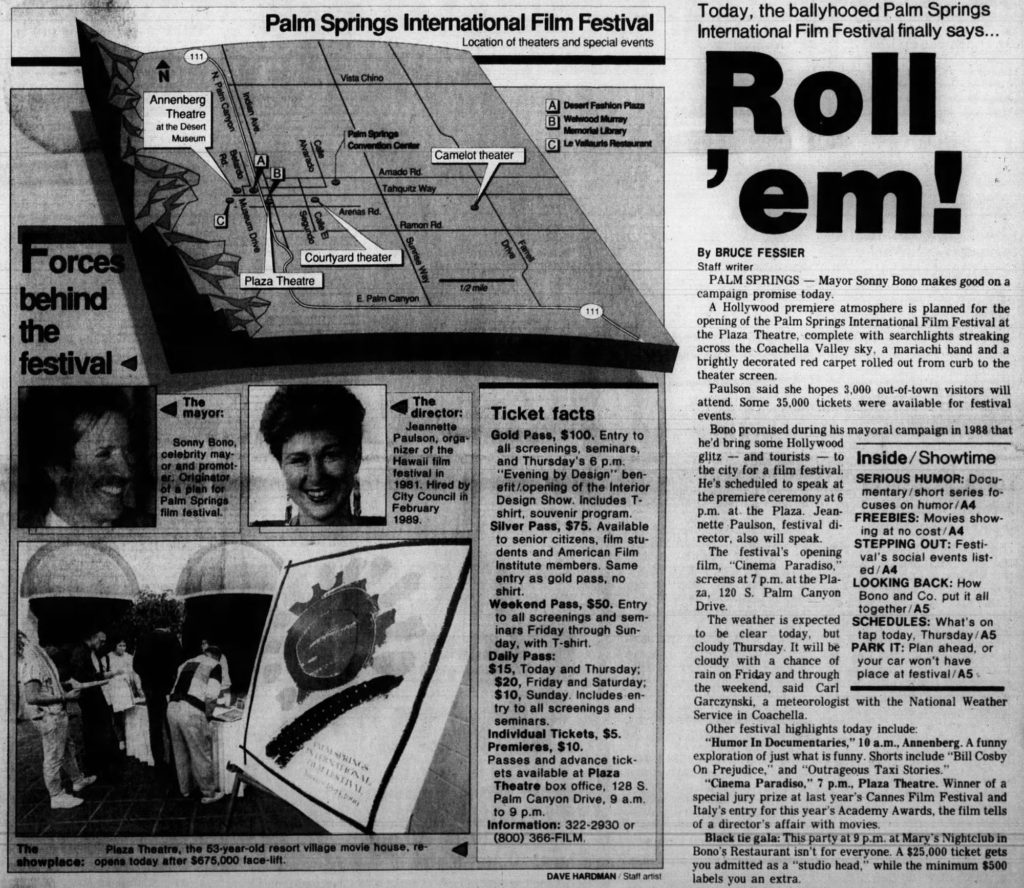
Lights! Camera! Action! The film festival kicked off on January 10. For $100 (which is more like $207 today), attendees could get a Gold Pass to see all of the screenings. That was a steal!
With 35,000 tickets available, the organizers hoped for 3,000 out-of-town visitors. The first film was Cinema Paradiso, which won the special jury prize at the 1989 Cannes Film Festival and was Italy’s entry for the Academy Awards. The film would quickly win the hearts of festival attendees.
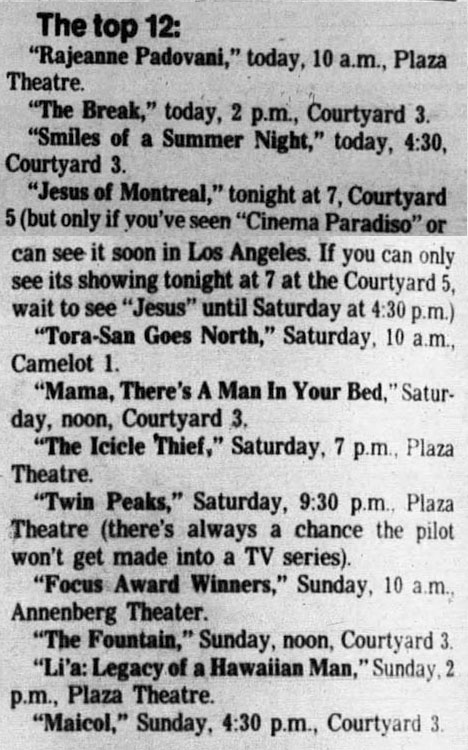
Bruce Fessier, Assistant Features Editor for The Desert Sun, wrote about how to see all 50 films in five days. He concluded that it’s an impossible task but offered a few tips how to tackle the list of films. Bruce also spoke with film festival scholar Deac Rossell who began his professional life as film critic for Boston After Dark. Rossell offered his suggestions, plus “some alternatives for filmgoers who won’t be able to see all the quality flicks they’d like to watch [that] weekend.” Not surprisingly, Twin Peaks made the cut (with a note that there is a chance the pilot won’t get made into a TV series).
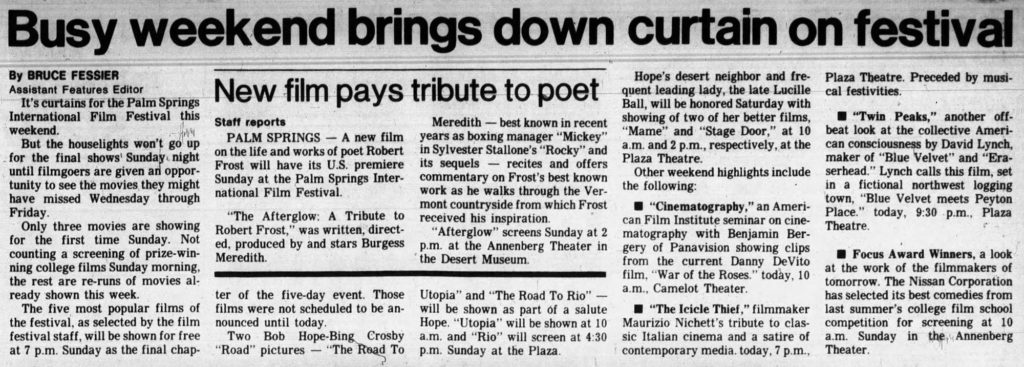
Fessier also discussed Twin Peaks in a January 13 write up: “another offbeat look at the collective American consciousness by David Lynch, maker of Blue Velvet and Eraserhead. Lynch calls this film, set in a fictional northwest logging town, “Blue Velvet meets Peyton Place.” today, 9:30 p.m., Plaza Theatre.”
I was unable to locate if any Twin Peaks stars, Mark Frost or David Lynch attended the 9:30 screening.
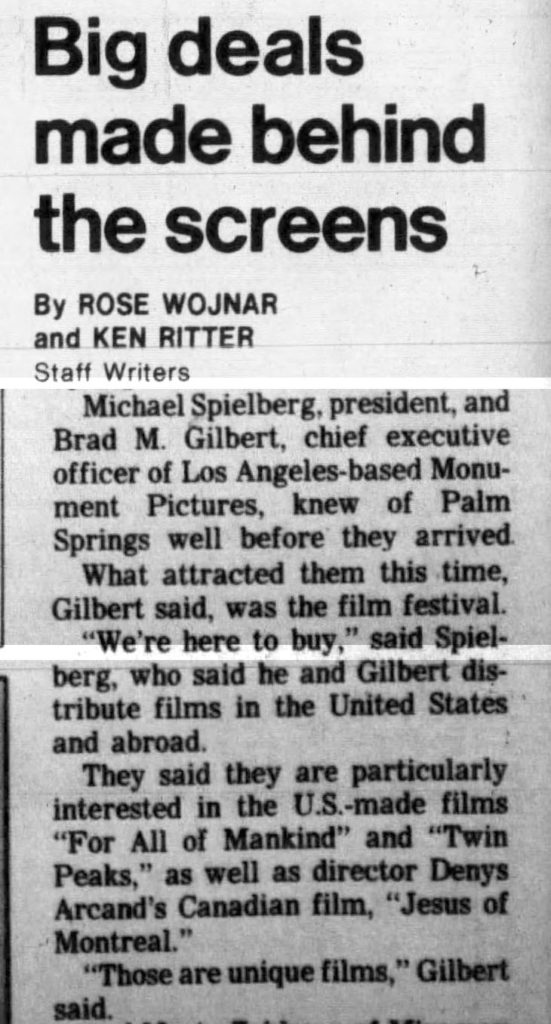
There was a lot of anticipation for the film which caught the interest of Michael Spielberg, president, Brad M. Gilbert, chief executive officer of Monument Pictures, calling Twin Peaks a “unique film.”
For the record For All Mankind is also a pretty stellar film. I’ve seen it on the big screen, own the soundtrack (including the expanded vinyl release) and have the Criterion Collection Blu-ray. An extremely well done documentary!
JANUARY 13, 1990 – THE PLAZA THEATRE IN PALM SPRINGS
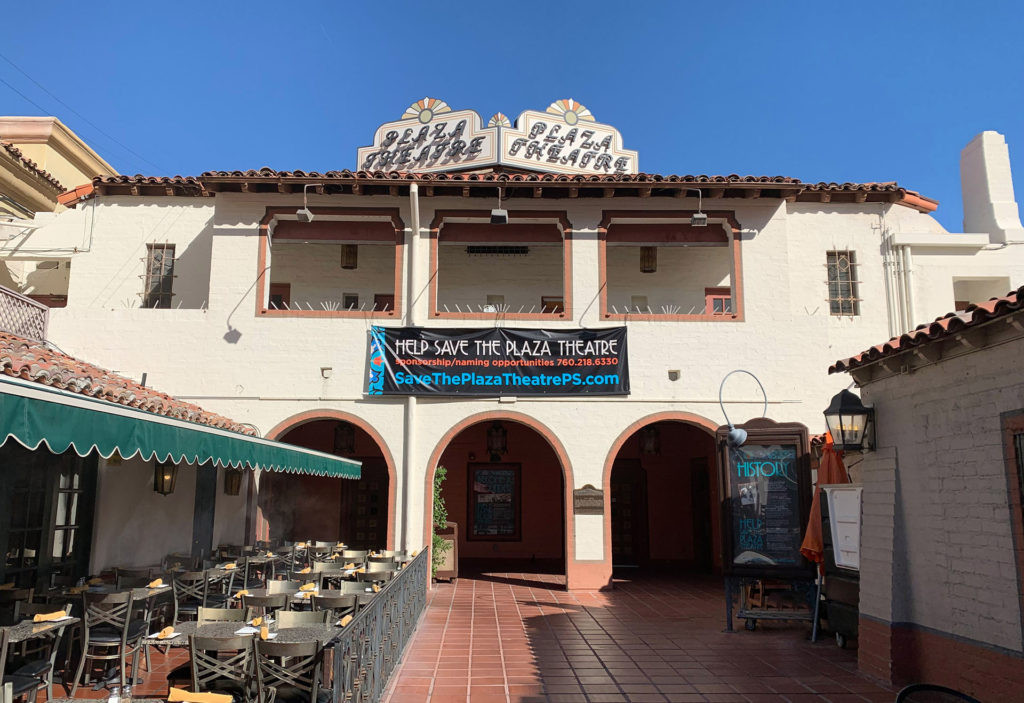
Following a $770,000 facelift, the historic Plaza Theatre in downtown Palm Springs (128 South Palm Canyon Road) was the heart of the festival, serving as the primary host complex. Renovation work on the theater continued until days before the January 10 opening. The theatre has a long history in Palm Springs which dates back to 1936.
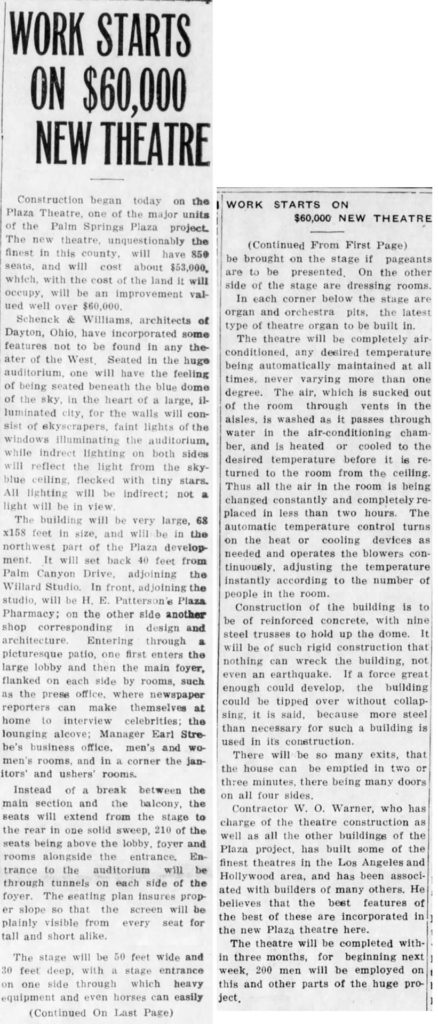
In the 1930s, Julia Carnell, a Dayton, Ohio, businesswoman and heiress to the National Cash Register Corporation fortune, reportedly paid Palm Springs pioneer Cornelia White $1 million to purchase 3.5 acres of what is now part of downtown Palm Springs. Carnell commissioned Dayton architects Schenck & Willams to design the La Plaza complex, including the Plaza Theatre, in a Spanish Colonial Revival style.
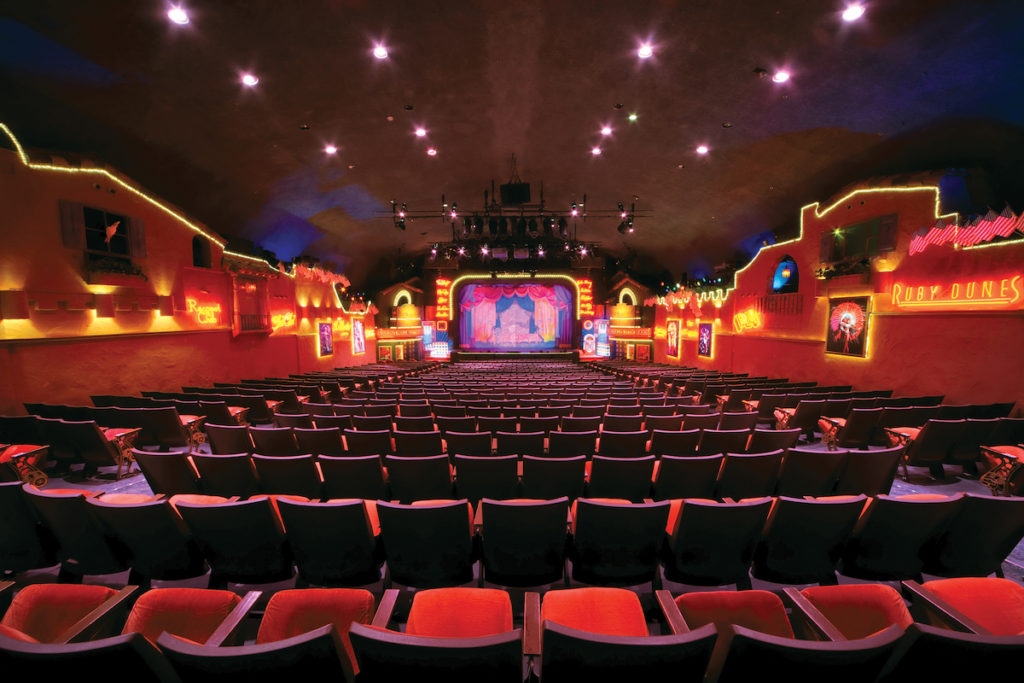
Work began on the 850-seat theatre on May 1, 1936 at a cost of about $60,000. Patrons would be seated beneath a blue dome representing the sky while a city façade with lights would line the walls. The theatre would also be air conditioned, a necessity for those hot summer months in the Coachella Valley. Construction was planned to be completed in three months.
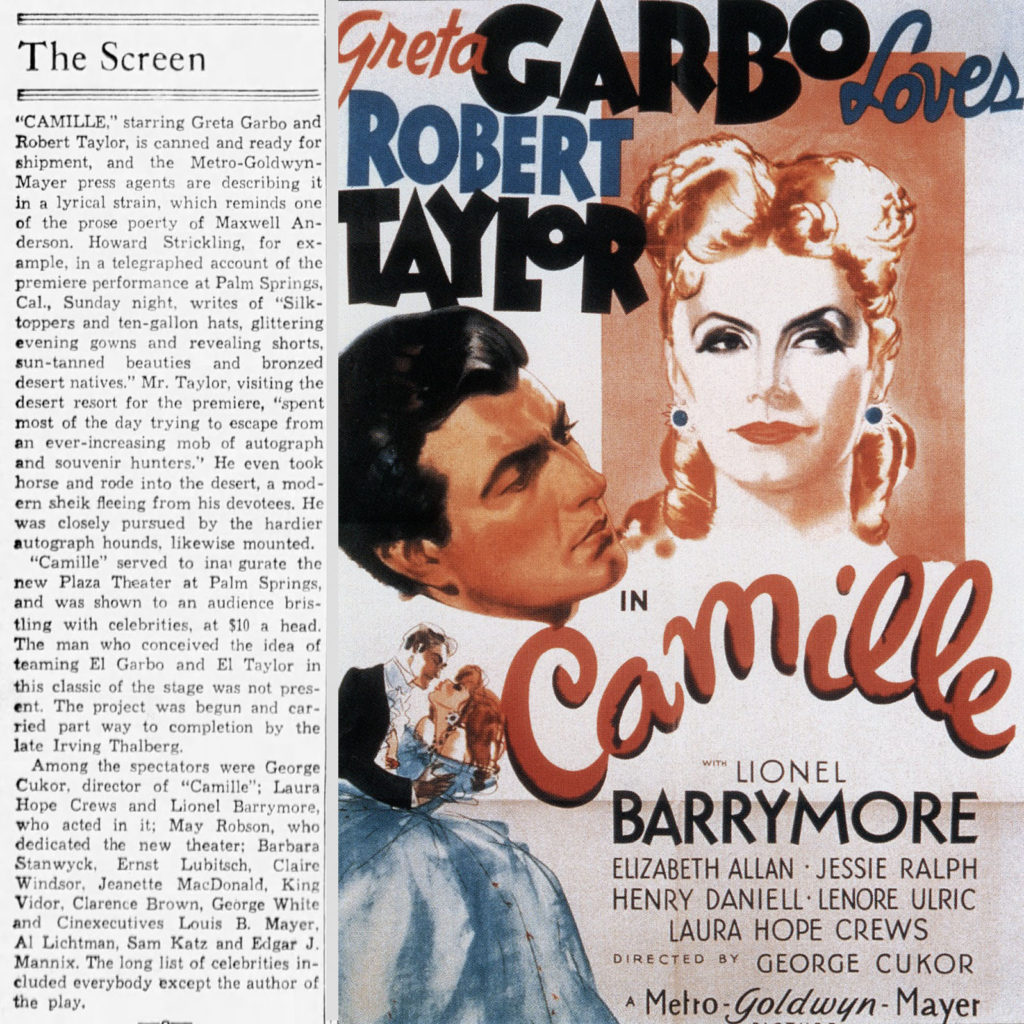
The Plaza Theatre opened on December 12, 1936 with the premiere of the George Cukor film Camille, with its legendary star, Greta Garbo, who allegedly slipped into the back of the theatre after the lights went down. Garbo’s co-star in the film, Robert Taylor, came with Barbara Stanwyck on his arm (they married a few years later).
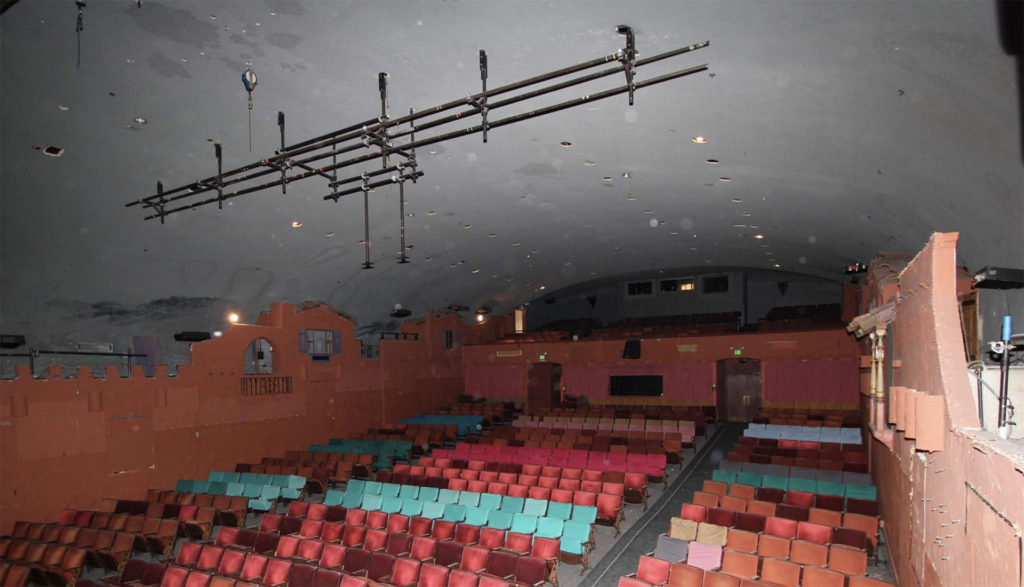
Over the years, the theatre had its share of struggles. In 1937, the theatre closed temporarily as they were unable to book any films. Metropolitan Theatres eventually purchased the lease on the Plaza in 1977 when the previous owner found it financially difficult to operate the desert cinema.
With single-screen theatres giving way to powerhouse multiplex cinemas in the early 1980s, Metropolitan split the theatre into two auditoriums. Competition increased with new multiplex theatres being added to the region, sparking more financial difficulties for the then-dated cinema. In 1988, Metropolitan offered the lease to the City of Palm Springs.
In 1991, the City Council awarded the Plaza Theatre lease to Riff Markowitz, a Canadian impresario and Hollywood TV producer. Markowitz and his wife, Mary Jardin, launched a vaudeville-type revue called The Fabulous Palm Springs Follies that ran in the theatre for 23 years.
Today, the theatre is in need of repair, and a comprehensive renovation plan was proposed in 2018. You can see more about the theatre and ways to help at SaveThePlazaTheatrePS.com.
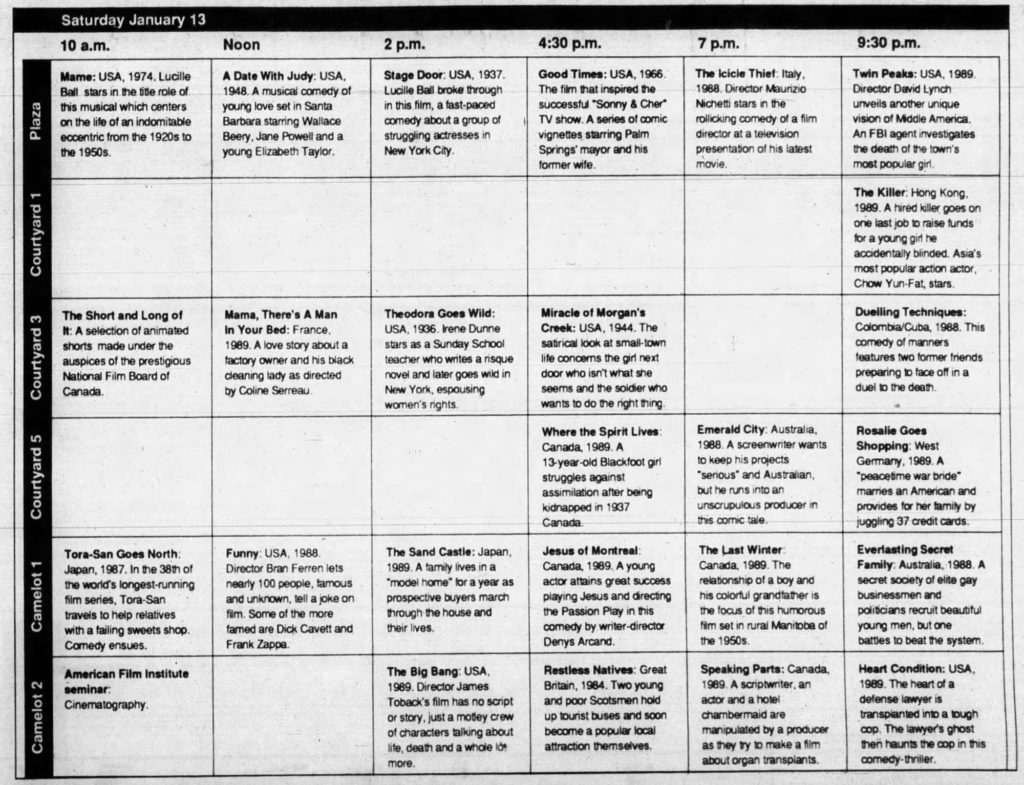
David Lynch and Mark Frost’s masterpiece pilot would be shown at 9:30 p.m. at the Plaza Theatre, which followed 7:00 p.m. screening of a festival-favorite, The Icicle Thief. It’s still pretty amazing that Twin Peaks had a prime spot in such a historic place.
JANUARY 14 – CAMELOT THEATRE II IN PALM SPRINGS
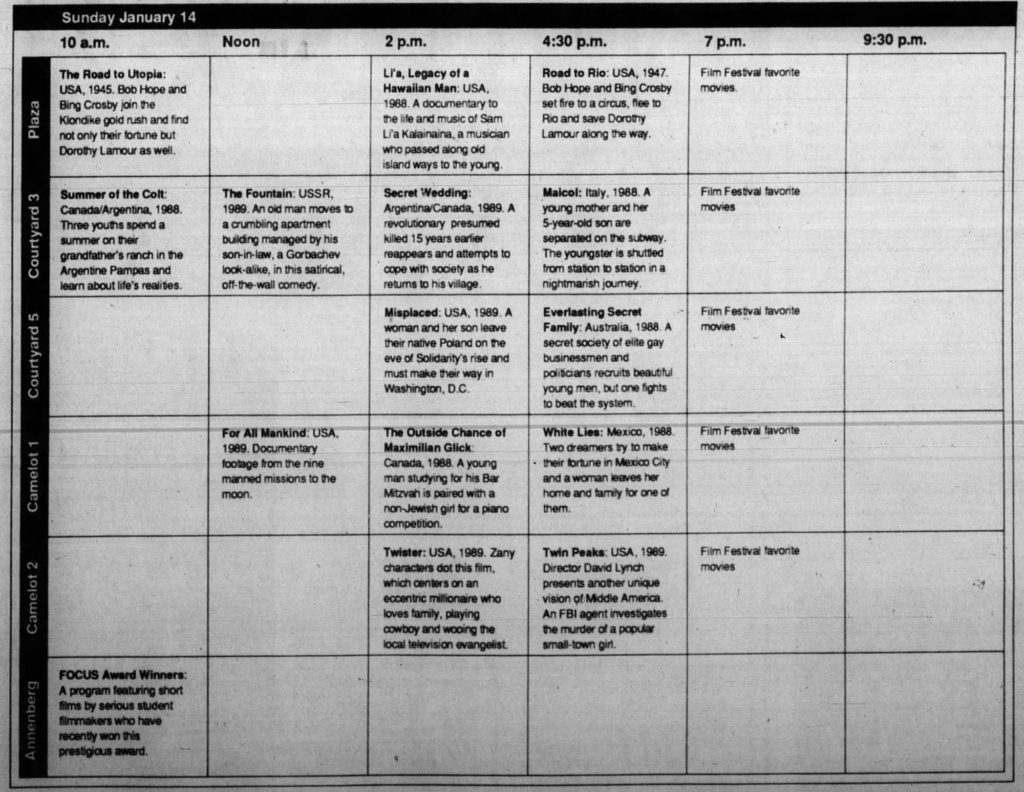
Twin Peaks had a second screening on Sunday, January 14 beginning at 4:30 p.m. in the Camelot Theatre II. The Plaza Theatre looks amazing but the original Camelot Theatre is the cinema of my dreams.
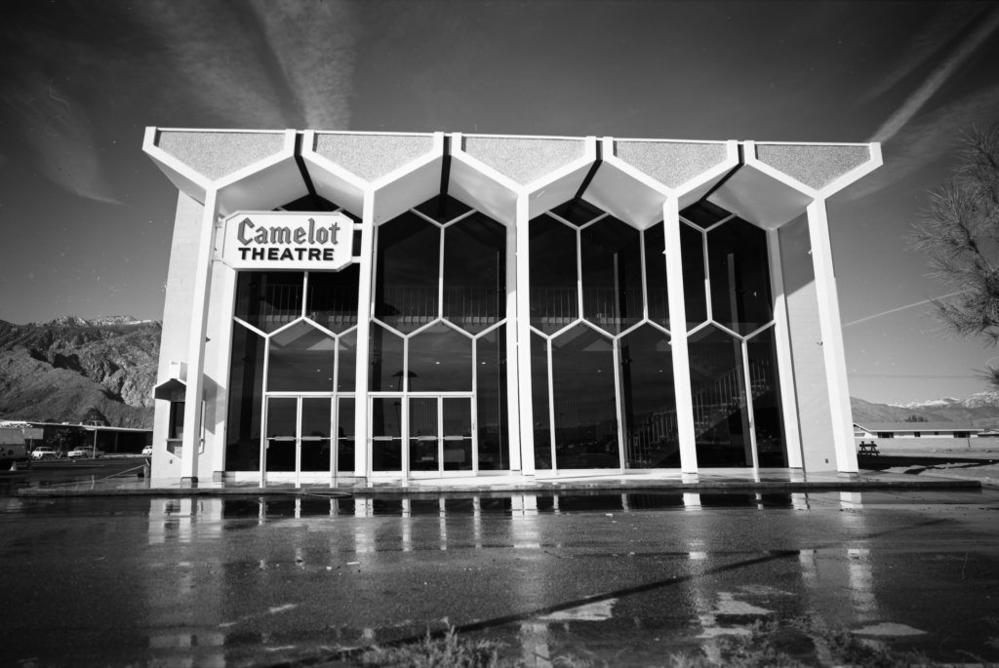
The original 625-seat Camelot Theatre located at the Palm Springs Shopping Center was opened on February 4, 1967 by then President of Metropolitan Theatres Sherrill Corwin at a cost of $750,000. This is the same company that purchased the Plaza in 1977. The heralded state-of-the-art cinema, equipped to the standards of only three other theatres in the United States, debuted with a star-studded screening of Dr. Zhivago for the United Fund.
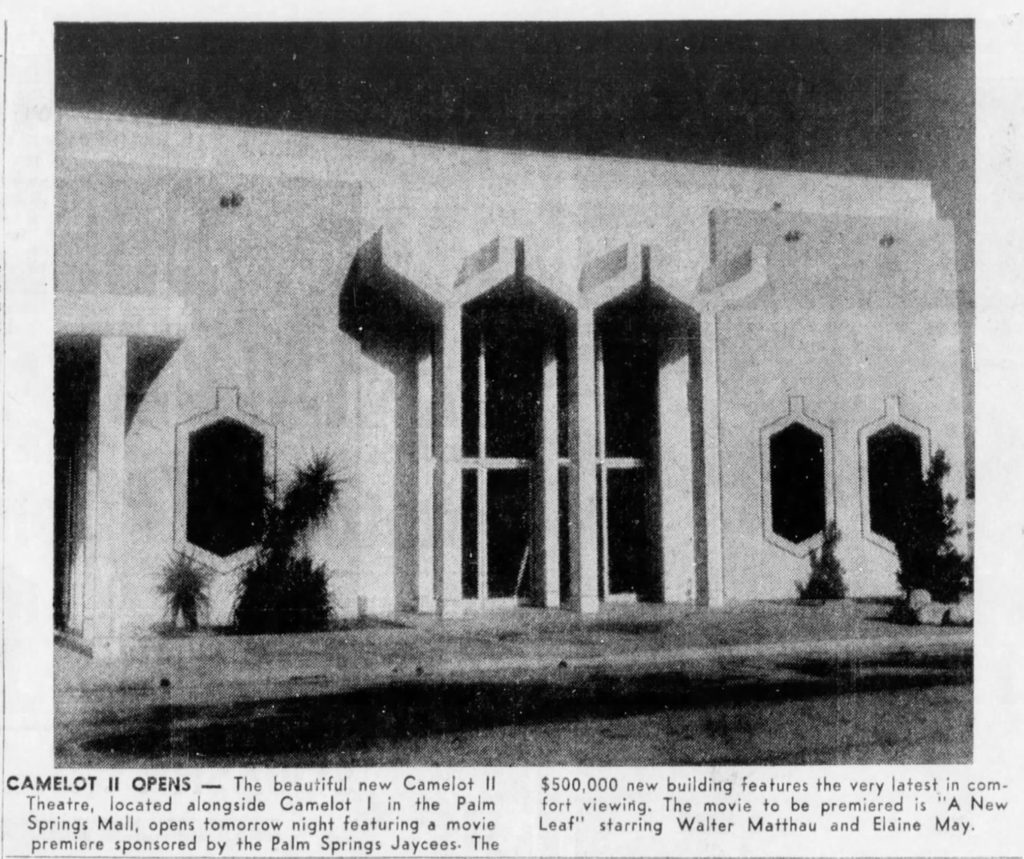
The 450-seat Camelot Theatre II was constructed in 1971 adjacent to the original theatre at a cost of $500,000.
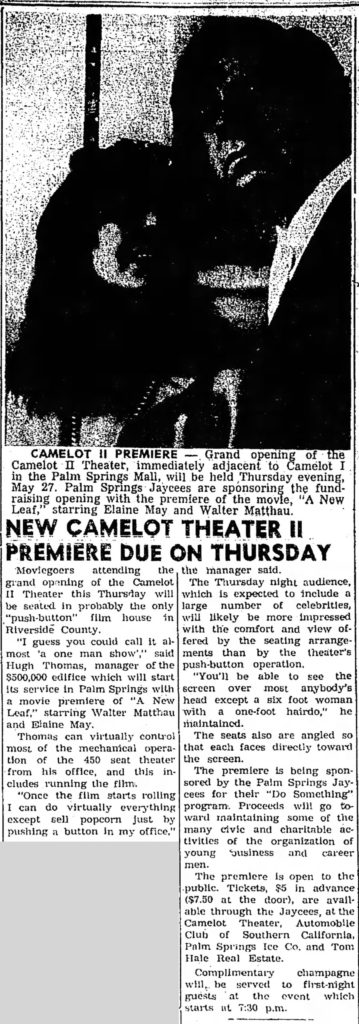
Camelot II was the only “push-button” theatre in Riverside County. The projectionist could literally start and stop films from a remote office with the push of a button. Each seat was angled so that they faced directly toward the screen. Long before the days of digital projection and today’s standards of luxury cinemas, this place must have been amazing.
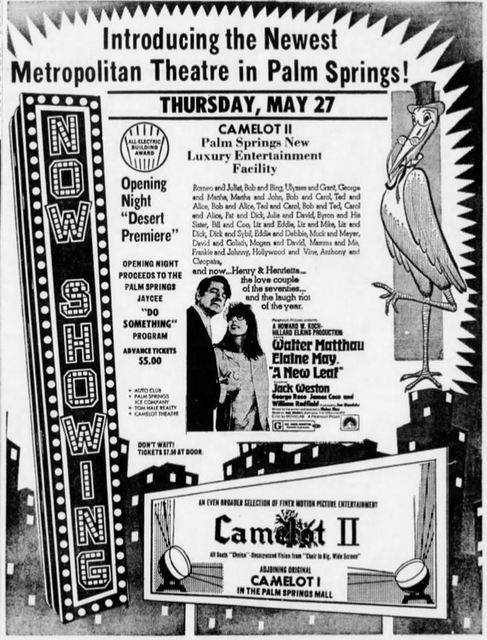
A New Leaf staring Walter Matthau and Elaine May, who also served as director, was the premiere film. That night, all proceeds benefited the Palm Springs Jaycees and a champagne toast was held at 7:30 p.m.
Metropolitan Theatres closed Camelot Theatres on January 15, 1992 after the Third Annual Palm Springs International Film Festival. The building remained vacant for several years until Ric and Rozene Supple purchased the building in 1999. They refurbished the building and turned it into a three-screen theatre which was later gifted to the Palm Springs Cultural Center in 2017. It’s located at 2300 E Baristo Road in Palm Springs.
CRITICAL REACTIONS TO TWIN PEAKS PILOT
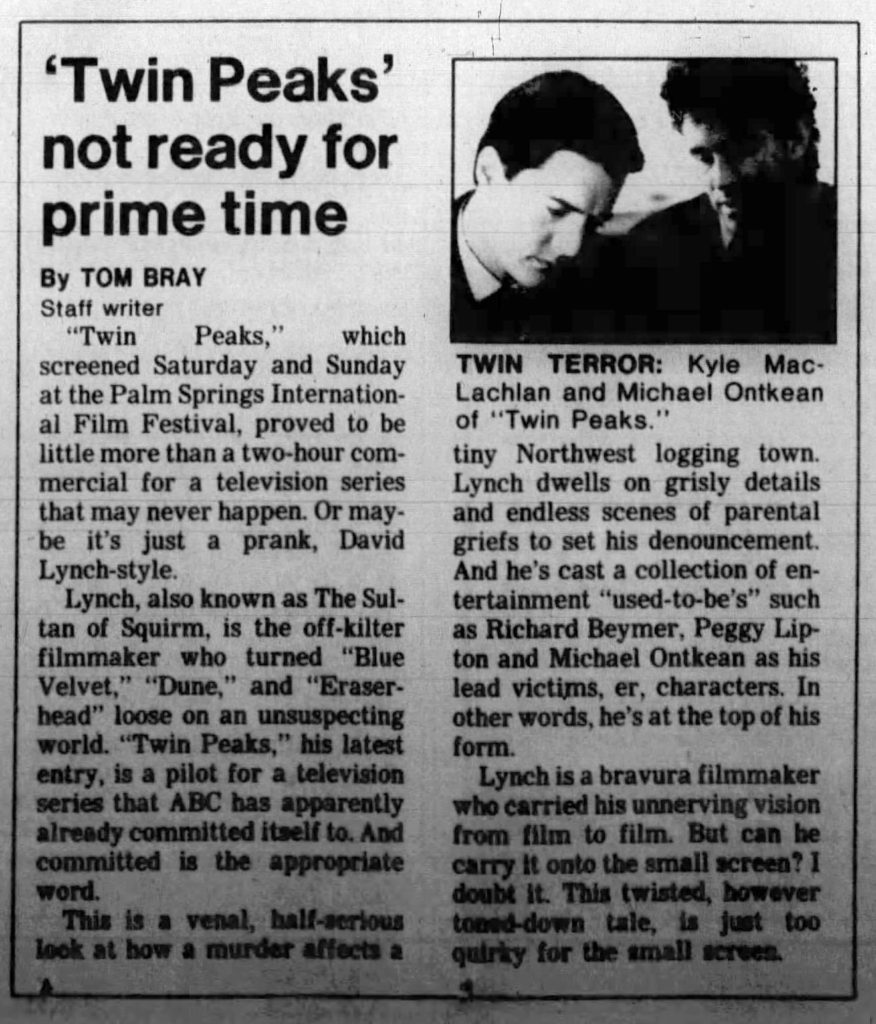
Despite much anticipation leading up to the screening, most reactions were negative. The Desert Sun’s Tom Bray clearly wasn’t a fan, and felt the pilot was “too quirky for the small screen.”
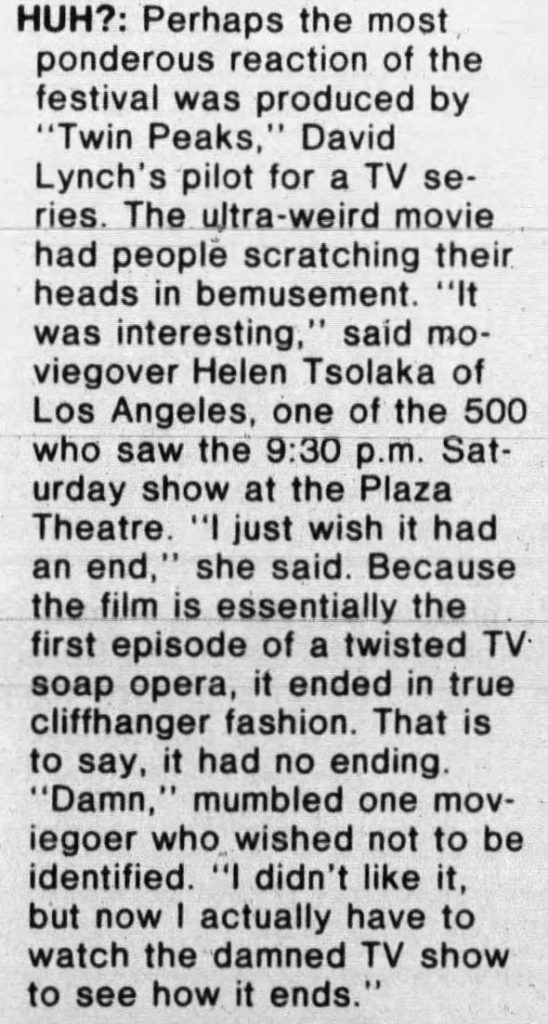
The paper also published some reactions from the 500 individuals in attendance for the 9:30 p.m. screening on January 13. The Sun wrote, “The ultra-weird movie had people scratching their heads in bemusement. ‘It was interesting,’ said moviegover Helen Tsolaka of Los Angeles … ‘I just wish it had an end’ … ‘Damn,’ mumbled one moviegoer who wished not to be identified. ‘I didn’t like it, but now I actually have to watch the damned TV show to see how it ends.’

Staff writer Jeff Rietveld said Twin Peaks was “the worst movie I’ve ever seen. At least this week.”
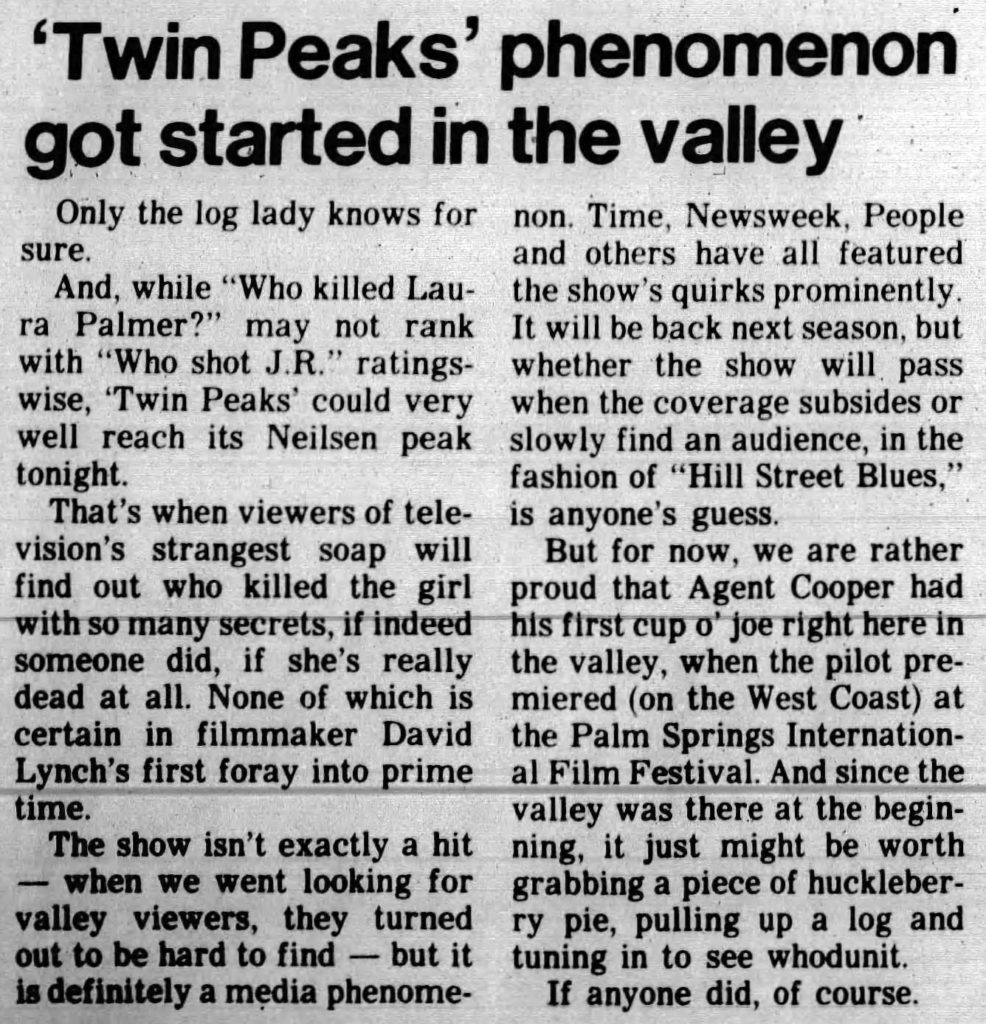
A few month later, an opinion piece was published in The Desert Sun on May 23, 1990. While critics and audiences didn’t enjoy the film when it was screened in January, the paper states they are “rather proud that Agent Cooper had his first cup o’ joe right here in the valley, when the pilot premiered (on the West Coast).”
BEYOND THE 1990 FESTIVAL
Toward the end of 1990, Mayor Sonny Bono created a video designed to drum up support and sponsorship for the 1991 Palm Springs Film Festival. David Lynch’s Twin Peaks gets a brief nod toward the end.
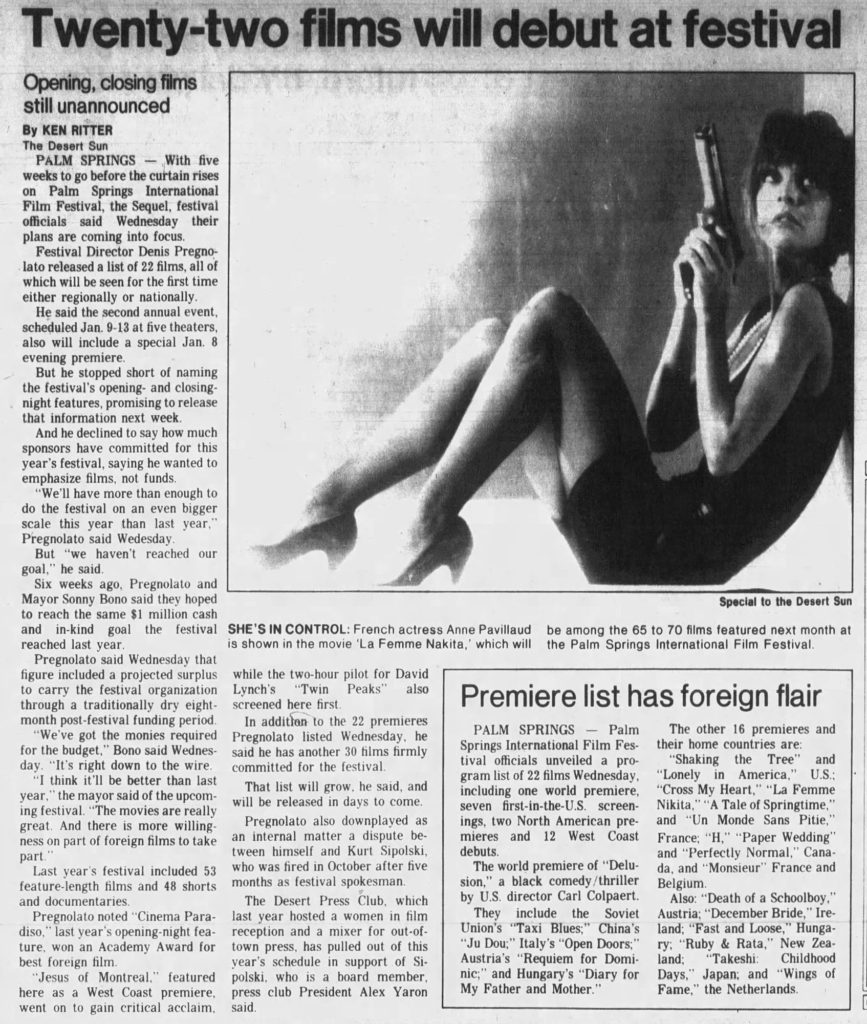
When the film slate was announced in early December, Desert Sun writer Ken Ritter was quick to point out that Twin Peaks “screened [at the 1990 festival] first.”
For a film that bewildered so many just 11 months earlier, it’s funny how success paired with nation-wide excitement changes perspective.
Discover more from TWIN PEAKS BLOG
Subscribe to get the latest posts sent to your email.

